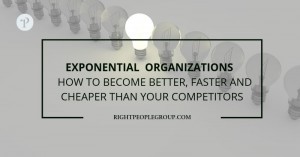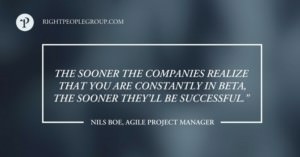WHAT IS AGILE? – AN 1-HOUR INTRODUCTION
Agile is a set of values and principles that in the last decades had a huge impact on how software is developed. In Scandinavia today, it is the norm to use agile principles and very few companies stick to a 100 % waterfall oriented approach.
However, there are many different kinds of implementation and many organisations consider themselves agile, even though their way of working is not a 100 % aligned with the agile principles. In this session we will answer the question “What is Agile” as it is seen from our perspective in the IT consultant industry. You will get an introduction to agile principles and agile software development.
Implementing new ways of working in organisations is hard, and it often fails – but our general experience in Right People Group, based on dialogue with hundreds of customers during the last 10 years, is that the change to agile principles in most cases is successful – both from a management perspective, but also from a software developer perspective. When implemented correctly, it simply gives more satisfied employees and more effective software development.
This video describes the principles and beliefs behind agile software development:
SCRUM – THE MOST COMMON AGILE METHODOLOGY
Scrum is a methodology based on the agile principles and it is the most widely used way of implementing agile. One important experience we have learned in dialogue with our customers is that selecting very strong product owners really makes the difference between success and failure of agile projects.
Key roles and concepts that you should know from Scrum are:
- Product Owner
- Scrum Master
- Sprint / Sprint planning
- Daily Scrum
- Retrospective
- Sprint backlog / user stories
- Product backlog
You can read about the definitions of the above here and the video below will give you an introduction to Scrum:
INTRODUCTION TO KANBAN
Most organisations start with Scrum and some of them then at a later point implement Kanban. Kanban is a very popular framework in agile software development. All chunks of work that different team members are handling are represented visually on a Kanban board, which allows the entire team to follow the development of the whole project at all times. Our general experience from customers is that this often leads to improvements and many of the best independent consultants that are working as agile coaches recommend this method.
Kanban is introduced and compared to Scrum in this article and in the video below:
MINIMUM VIABLE PRODUCT
The “Minimum Viable product” (or MVP) was made popular by Eric Ries when publishing the book “The Lean Start-up” in 2008. The core concept of MVP is very well-suited to the philosophy behind agile software development. In recent years, this philosophy has grown very popular especially among tech start-ups.
We are seeing that the pace of skilled start-ups that adhere to this philosophy is threatening many of the core services that were previously owned by enterprise companies, e.g. in the financial sector. Being aware of this risk of disruption, the enterprise companies are increasingly trying to adopt the concept and mindset, since a short “time to market” is crucial to stay competitive.
The video below gives a very good introduction to MVP illustrated by 3 examples:
TECHNICAL DEBT
In our first video, we saw how the developer made the choice of only doing part of the database layer that was needed to deliver the relevant functionality. Decisions like these might be right to make, but it can also lead to the potential danger of having too many non-finished parts in the overall system architecture giving a “technical debt”.
Technical Debt is a concept introduced by one of the Agile Manifesto authors, Ward Cunningham. As said, taking short cuts in order to e.g. put a viable product on the market faster can be a good decision, but as the metaphor implies, one should be conscious that there is a debt to pay sooner or later, simply because the quickest solution in a short perspective will rarely be the most optimal in the long run.
If there is no reason for taking a coding short-cut and a quick and dirty solution is not implemented to achieve business value but simply because the team is not ambitious or skilled enough, then technical debt has nothing to do with agile methods and business thinking, then it is just bad work!
Actually, in our experience, software developers that are not sufficiently skilled and focused on quality are the biggest reason for technical debt. We also see that the interest paid on technical debt is huge. Increasing technical debt makes changes to a software product increasingly hard to implement, which is equal to killing the product since a static software product cannot survive.
Here is an introduction to technical debt:
WHAT AGILE ISN’T
In the agile manifesto, certain things are prioritized over others. This does not mean that the things prioritized less are not valued and should not be done at all. As an example, some software developers do not like to document their solutions, and you might hear from such developers that documentation is against the agile principles. This is wrong. This short article describes very well how the agile manifesto should be understood:
https://www.linkedin.com/pulse/what-agile-isnt-patrick-becka
SAFE – SCALED AGILE FRAMEWORK
It is hard to succeed with software development projects, and it is very hard to succeed with large and complex software development projects. As many enterprise organisations adopt the agile mindset, it also means that there is a need for having a method for conducting very large and complex projects using an agile mindset. “SAFE” is the most commonly used agile methodology to handle very large and complex projects. Here is an introduction to it:
WHY AGILE FAILS
Like with any change of organizational processes, introducing agile has a risk of failing. In our experience, the software developers are in general quite keen to go agile, but it requires the management to be willing to let go of certain control mechanisms that they used to have. It also requires a continuous involvement of the business side of the organisation, meaning in real life that they simply need to allocate time for it.
ARE YOU AN INDEPENDENT CONSULTANT OR CONTRACTOR?
Sign up for our newsletter to receive IT contract jobs by email relevant to your profile and geographical preferences.
DO YOU NEED AN AGILE EXPERT?
Send us an email at [email protected] for a CV and hourly rate of an agile expert who matches your project and requirements or read more about our services in this field under Agile project manager or Agile development expert.













